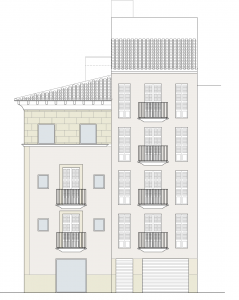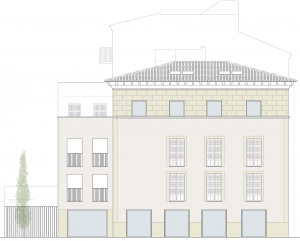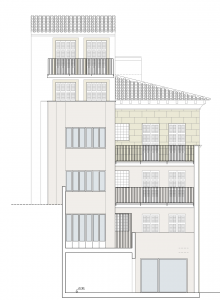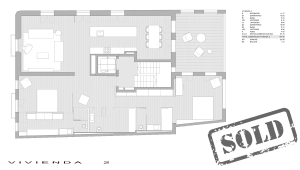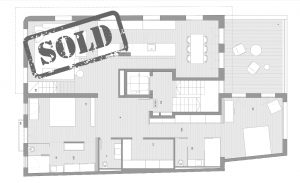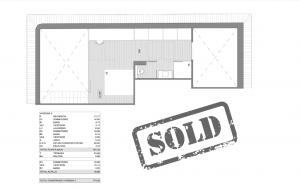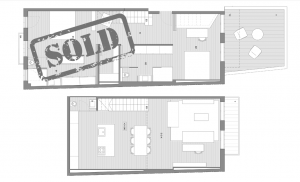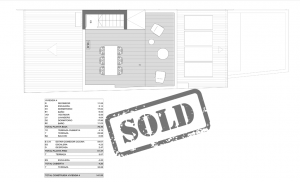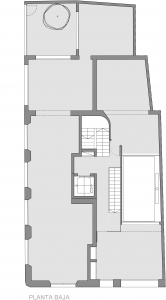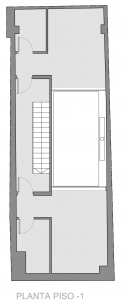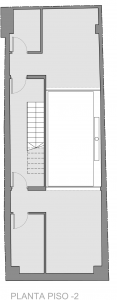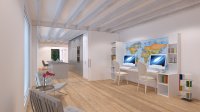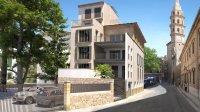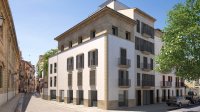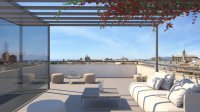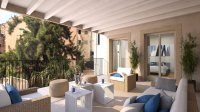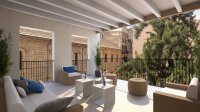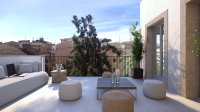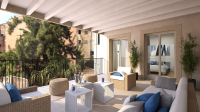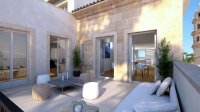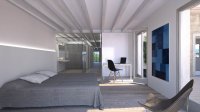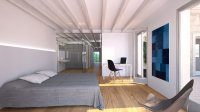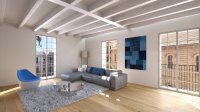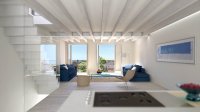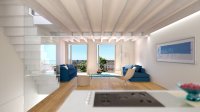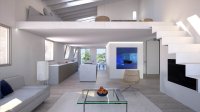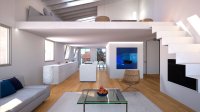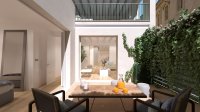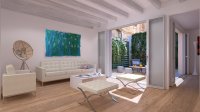The interior carpentry will be generally of standard untreated wood, with smooth doors, fittings, and 7 cm doorframes in the same veneer, over red pine preframe.
Building in Llorenç Bisbal square

Llorenç Bisbal. Overview.
Rehabilitation of two buildings at the Llorenç Bisbal Square (Plaça Batle Llorenç Bisbal) in Palma. These buildings of great cultural interest, as evidenced by the fact that the Associació per a la Revitalització dels Centres Antics (ARCA, Antique Centers Rehabilitation Center) prevented its demolition in 2007.
Floor Plans
Below is a complete gallery of project plans for you to explore freely. If you have any questions, please let us know.
Quality Specifications
The Quality Specifications report shows detailed information on the quality of the materials used in the construction of the building. The report has the following sections:
All stairs will have metal bars railings with stainless steel (AISI 316) handrails, fixed to vertical surfaces in accordance with standards on the removal of architectural and urban development barriers. The railings on balconies will be made of painted iron plates.
Finishes have been chosen with comfort and durability criteria in mind.
The flooring of the house will be of floor in oak or similar. Regarding the flooring of the garage, a continuous cement mortar floor has been chosen. Rooms in the basement in porcelain tiles. The rest of the areas will be in continuous cement mortar floor, uniform color. Doorways, stairs and floor landings will be paved with 60x30x3cm honed limestone tiles. Floors on the terraces and balconies will be paved with60x30x3cm quarry faced limestone tiles.
Bathroom vertical coatings in humid areas will be tiled with large format white ceramic tile applied using adhesives on the cement mortar parging. On the other walls of the bathrooms, matte Venetian stucco will be used. In kitchens, vertical walls between kitchen furniture and worktop will be coated with Silestone in Zeus White or similar. The service areas will be tiled with 20 × 30 cm. white ceramic tile applied using adhesives on the cement mortar parging. For the remaining, smooth plastic anti mildew paint on plastering in all rooms.
Plastered interiors, rodded and floated with cement mortar and plastered with fine plaster, acustically insulated or prefabricated plasterboard partitions (Pladur type). In zones where a concrete slab exists, it will be visible.
The materials and the systems chosen ensure hygienic conditions, health and environmental protection, so that they reach an acceptable health conditions and air tightness in the indoor environment of the building. We can assure that the building does not damage the environment in their close surroundings, and we ensure an appropriate waste management. The building has been designed taking into account environmental measures envisaged to achieve a rational use of the energy needed, reduce the consumption to sustainable limits and obtain a part of this consumption from renewable energy sources .
The new building includes hydraulic facilities that include plumbing, drainage and rainwater collection, BT wiring, fire protection system, a lift and a car lift, extraction and intake of air facilities, and special facilities such as telephone and telecommunication facilities.
Water supply comes from the Palma municipal water mains, duly authorized, in compliance with the terms of potability and quality care, from the physical, chemical and microbiological viewpoints. There will be a supply cabinet at the entrance hall to the building Water supply will be taken from the network owned by the Municipal Water and Sewage Company (EMAYA) . Domestic water will be directly taken from EMAYA's supply, since it provides enough pressure. All plumbing shall be made with copper pipes normalized to Basic Standard, NTE and UNE with one network (lagged copper for Domestic Hot Water) for a rated pressure of 10 Atms, with shut-off valve and appropriate accessories for a rated pressure of 15 Atm., whereas the fire fighting network shall be galvanized steel pipe. The layout of the plumbing network is detailed in the drawings. All plumbing lines will hang from the ceiling, separated at least by 30 cm. from any electric line or cabinet, and in no case over them. Moreover, hot water will always be above the cold water pipe, and separated at least by 4cm. Lines will always run vertically towards the appliances, never allowing inclined layouts. First-quality chrome-plated fittings on all bathrooms and toilets. Vitrified porcelain toilets with wall-concealed tank and inox Two-button partial flush system. Vitrified porcelain wash basins.
Separated rainwater and sewage networks. The rainwater harvesting system is made by connecting to the municipal storm water runoff, with a minimum slope of 1.5% and a maximum of 2%. Sewage collection shall be connecting to municipal sewage. Sewage collection on all plants will be by gravity, with minimum slope of 1.5% and a maximum of 2%. Toilets will be connected to corresponding drainpipe by a shank, avoiding pipes greater than 1.5 m. in length. Flat roofs will have trapped drains with cap. Stainless steel trapped drains will be at least 160 mm diameter and 110m bottom outlet. All drains will be protected with a cast-iron grille (or basket in case of gravel-covered surfaces). PVC drainpipe and siphon cans in bathrooms. Diameters are stated in the diagrams. They will hang from ceiling, concealed by false ceilings, with a minimum slope of 1.5%. Each appliance will have its own trap. The drains of the toilets will be stainless steel siphons. Moreover, a drainage system in PVC will also be projected, integrated into the main one, to evacuate the water drip from the air conditioning machinery.
Power will be taken from the network owned by the company ENDESA. The power supply will be 230/400 V, through the underground connection to the utility ground.
The current regulation has been taken into account in the project: Low Voltage Electrotechnical Regulation (TBR), approved by RD 842/2002, of 2 August 2002 and complementary ITC.
All the rooms have natural and/or mechanical ventilation. En la cocina se instalará un sistema de ventilación forzada para evacuación de humos. Las viviendas dispondrán de un sistema general de ventilación que será mecánica. Para garantizar la circulación del aire desde los locales secos a los húmedos se ejecutará la obra según estos criterios:
- Los aseos, las cocinas y los cuartos de baño dispondrán de aberturas de extracción.
-
Las particiones situadas entre los locales con admisión y los locales con extracción dispondrán de aberturas de paso. Existen carpinterías exteriores de clase 0 o 1 según norma UNE EN 12207:2000. Estas carpinterías tendrán las siguientes aberturas de admisión:
- Juntas de apertura. Las aberturas de admisión comunican directamente con el exterior. Según el apartado 3.1.2 del HS3. Las cocinas, comedores, dormitorios y salas de estar deben disponer de un sistema complementario de ventilación natural. Para ello se dispondrá una ventana exterior practicable o una puerta exterior. Las cocinas deben disponer de un sistema adicional específico de ventilación con extracción mecánica para los vapores y los contaminantes de la cocción. Para ello se dispondrá un extractor conectado a un conducto de extracción independiente de los de la ventilación general de la vivienda que no puede utilizarse para la extracción de aire de locales de otro uso con salida en la cubierta. El garaje, en la planta sótano, dispondrá de un sistema de ventilación mecánica con aportación de aire directa desde el exterior.
There will be a five-stops lift with built-in machinery, acoustically insulated, incorporating emergency stop system for the unlikely case of downward uncontrolled elevator rope, permanent (24 hour) two-way communication system with the manufacturer's service center and overload control in; T2 telescopic doors or similar, according to the manufacturer's documentation. First stop in the basement, the last in the 2nd floor. Cabin will comply with the Decree 20/2003 of February 28, 2003, Law 3/93 of Accessibility and Removal of Architectural and Urban Development Barriers in the Balearic Islands, in such a way as to allow people with reduced mobility and/or communication, access and circulation through the building.
Stainless steel finish in doors. Interiors in glazed finish. Floor paved with a single piece of limestone. Half mirror.
There will also be a car lifting platform, allowing people aboard, DHC model with dimensions 520x250cm, non-slip floor covering, alarm button, emergency light in operating panel, Braille and backlit controls. Capacity: 2500 Kg, travel 5.40 m, with an engine power: 5.5 HP. Three stops. Speed: 0.09 m / s or 0.13 m / s. The platform lift is made under the provisions of the Machinery Directive and Directive 2006/42-CE 98/37-CE.
The telecommunications facility complies with the Royal Decree-Law 1/1998, of February 27, in which are set the foundation for the legal development of the rules governing the Common Telecommunications Infrastructures for accessing telecommunication services in Interior of Buildings, as well as Equipment and Telecommunication Systems Installation Activity. The Common Telecommunications Infrastructure (CTI) must include the required elements to set up three basic networks that guarantee access to
- Audio and television broadcast signals by terrestrial and satellite waves.
- Telephony service available to the public.
- Telecommunication services by cable. The building telecommunications installation will include the "Minimum Technical specifications in telecommunications buildings", that specifies positioning and sizing of enclosures, manholes and pipelines that host the Common Telecommunications Infrastructure of buildings, all of which is justified and developed in the project.



